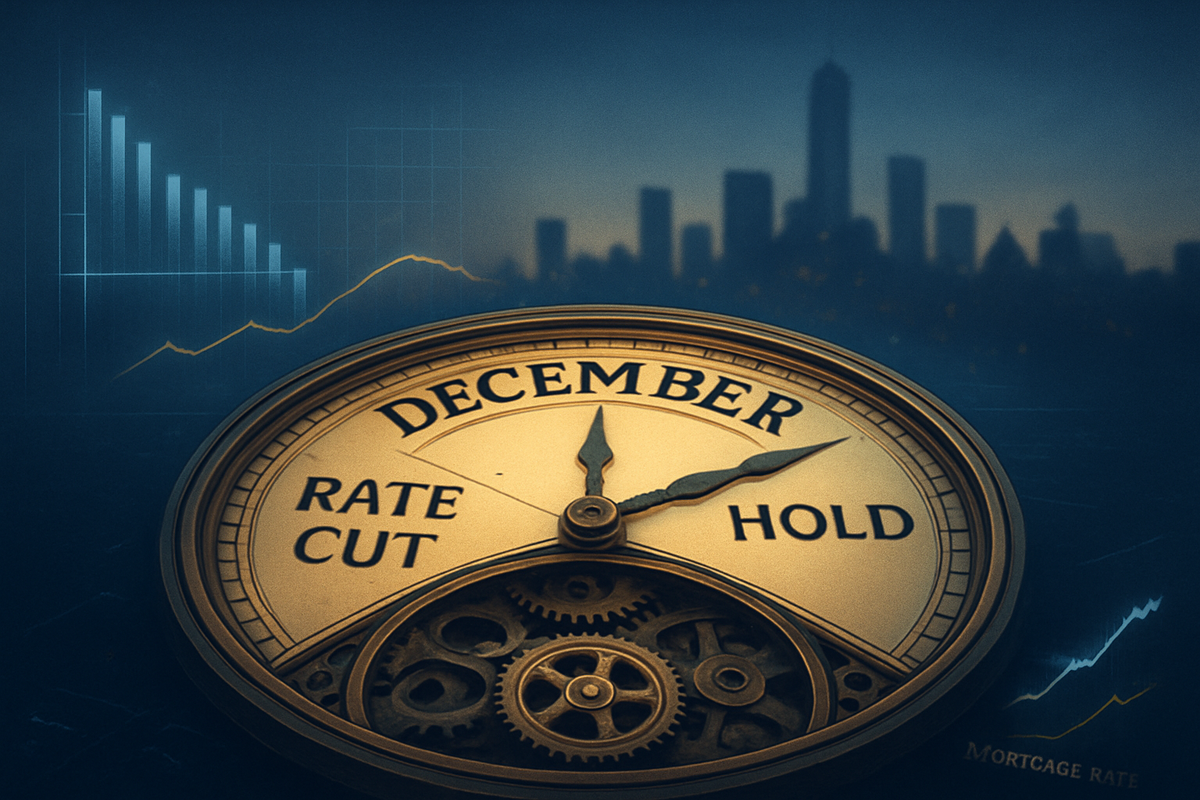
As November 2025 draws to a close, financial markets are keenly focused on the Federal Reserve's upcoming December 9-10 meeting, where the central bank will decide whether to implement a third interest rate cut of the year. The prospect of further monetary easing has sparked intense debate among Fed officials and financial analysts alike, creating a climate of heightened anticipation and volatility. A potential rate cut would carry immediate implications for borrowing costs, stock market performance, and the U.S. dollar, influencing everything from mortgage rates to corporate investment strategies.
The central question looming over the economy is whether the Fed will prioritize supporting a cooling labor market and mitigating downside risks to growth, or remain steadfast in its fight against persistent inflation. This delicate balancing act is further complicated by recent "data blackouts" stemming from a government shutdown, which have delayed the release of crucial economic indicators, leaving policymakers with an incomplete picture of the economy's health.
The Fed's Dilemma: Balancing Growth Against Stubborn Inflation
The Federal Reserve's journey through 2025 has been marked by a significant pivot towards monetary easing. After holding rates steady in January, March, May, and July, the Federal Open Market Committee (FOMC) initiated its first rate cut in September, followed by a second in October, bringing the federal funds rate to a target range of 3.75% to 4.00%. However, as the December meeting approaches, the consensus within the Fed has fractured, with a clear division between "dovish" and "hawkish" camps.
Proponents of a December rate cut, including New York Fed President John Williams and San Francisco Fed President Mary Daly, point to a softening labor market, characterized by slowing job growth and an unemployment rate that rose to 4.4% in September—its highest since October 2021. Governor Christopher Waller has also expressed support for a cut, viewing it as "additional insurance" against further economic weakening. They argue that underlying inflation is nearing the Fed's 2% target, especially when excluding tariff effects, and that a cut is necessary to support economic activity and address cooling consumer spending, as evidenced by slower U.S. retail sales in September.
Conversely, "hawkish" officials like Boston Fed President Susan Collins and Atlanta Fed President Raphael Bostic remain wary of persistent inflation, which has hovered above the 2% target for nearly five years. They caution that a premature rate cut could reignite price pressures, forcing the Fed to reverse course later. Chicago Fed President Austan Goolsbee has also expressed unease about the stalled progress towards the 2% target. The recent government shutdown has exacerbated this uncertainty, delaying critical October and November inflation and jobs reports, leaving the Fed without a full data set for its decision. Despite this internal division, market expectations for a December rate cut have surged to 79-85% by late November, influenced by recent dovish signals from influential Fed officials.
Corporate Fortunes: Who Wins and Who Loses from a Rate Cut?
A Federal Reserve interest rate cut in December 2025 would undoubtedly reconfigure the landscape for public companies, creating distinct beneficiaries and those facing headwinds. The general reduction in borrowing costs and potential stimulation of economic activity would have varied impacts across sectors.
Potential Winners:
- Technology and Growth Stocks: Companies in the technology sector, particularly high-growth firms, often rely on external financing for innovation and expansion. Lower interest rates would reduce their borrowing costs, boosting profitability and making future earnings more valuable. Hyperscalers like Amazon (NASDAQ: AMZN), Microsoft (NASDAQ: MSFT), Google (NASDAQ: GOOGL), and Meta Platforms (NASDAQ: META), with their substantial AI investments, would benefit from cheaper capital. Semiconductor companies such as NVIDIA (NASDAQ: NVDA) and AMD (NASDAQ: AMD) would also likely see increased investment in the tech sector.
- Real Estate and Homebuilders: A rate cut would directly translate to lower mortgage rates, stimulating demand in the housing market. This would benefit major homebuilders like Pultegroup (NYSE: PHM), D.R. Horton (NYSE: DHI), and Lennar (NYSE: LEN) through increased sales and construction activity. Construction material suppliers such as Builders FirstSource (NASDAQ: BLDR) and Mohawk Industries (NYSE: MHK) would also see a boost.
- Consumer Discretionary: With lower borrowing costs for credit cards and auto loans, consumers would have more disposable income, leading to increased spending on non-essential goods and services. Companies like PayPal (NASDAQ: PYPL) could benefit from higher payment volumes, while auto manufacturers such as General Motors (NYSE: GM) might see increased demand.
- Industrials and Capital-Intensive Industries: Firms requiring substantial capital for equipment and infrastructure, like Caterpillar (NYSE: CAT), would find it cheaper to finance new projects, potentially leading to increased investment and expansion.
- Small-Cap Companies: Smaller companies often rely heavily on external financing. Lower rates would reduce their cost of capital, making it easier to borrow and accelerate growth plans.
Potential Losers or Less Positively Impacted:
- Financials (Banks): While not universally negative, banks could face challenges from compressed Net Interest Margins (NIMs), as the interest they earn on loans may fall faster than the interest they pay on deposits. Large banks like JPMorgan Chase (NYSE: JPM) might experience NIM pressure. However, increased refinancing activity could partially offset these pressures, and regional banks might see reduced default risks.
- "Bond-Proxy" and Ultra-Defensive Sectors: Sectors typically favored for stable income and dividends, such as certain utilities and consumer staples, might see investors rotate capital towards higher-growth assets as bond yields fall. While Verizon (NYSE: VZ) could benefit from refinancing its debt at lower rates, its relative appeal as a high-dividend stock might diminish for some income-focused investors compared to now-lower bond yields.
A Wider Lens: Broader Economic Trends and Global Ripple Effects
The Federal Reserve's potential December 2025 rate cut is more than just a monetary policy adjustment; it's a significant marker within broader economic trends and carries substantial ripple effects both domestically and internationally. Such a move would likely be interpreted as a "risk management cut," a proactive measure to sustain economic demand and mitigate potential slowdowns, particularly in the labor market.
Domestically, lower borrowing costs for consumers and businesses would aim to stimulate spending and investment. This could boost the housing market, encourage corporate expansion, and generally support stock market gains as investors shift from lower-yielding bonds to equities. However, a prolonged period of low rates also carries the risk of encouraging excessive risk-taking and potentially inflating asset bubbles. Internationally, a rate cut would likely lead to a weaker U.S. dollar, making U.S. exports more competitive but increasing import costs. This could also encourage capital outflows from the U.S. to other countries offering higher returns, potentially benefiting emerging markets. If the Fed cuts rates while other major central banks maintain or tighten their policies, it could lead to significant global central bank policy divergence, further impacting currency valuations and capital flows. Historically, Fed rate cuts have often been deployed to stimulate growth during economic downturns, as seen during the early 1990s recession, the dot-com bubble burst, and most dramatically during the 2007-2008 Global Financial Crisis and the COVID-19 pandemic. These precedents highlight the Fed's role in stabilizing the economy and preventing deeper crises.
What Comes Next: Navigating the Post-Cut Landscape
Looking ahead, a Federal Reserve interest rate cut in December 2025 would usher in both short-term shifts and long-term possibilities, necessitating strategic adaptations for businesses and investors alike. In the immediate aftermath, consumers and businesses would likely experience reduced borrowing costs, leading to potential increases in consumer spending and business investment. The stock market would generally react positively, with investors shifting towards equities, though initial volatility is always possible. Bond yields would likely decrease, and the U.S. dollar could weaken, making international equities more appealing.
In the long term, the effectiveness of the rate cut hinges on the underlying economic conditions. If the cut successfully stimulates growth without reigniting inflation, it could lead to sustained economic expansion. However, if the cut is a response to a deeper economic malaise, its impact might be limited, and a slowdown or even recession could still occur. Businesses would need to prioritize debt management and refinancing to capitalize on lower interest expenses. Capital expenditure and expansion plans, previously shelved due to higher financing costs, could be revisited. Companies must also adapt pricing strategies, manage supply chains effectively, and focus on cost efficiency to maintain profitability in an evolving economic environment. Potential scenarios range from a "soft landing," where the Fed successfully avoids a recession, to a "mild recession/stagnation" if deeper economic headwinds persist, or even an "inflationary resurgence" if price pressures reignite. Another risk is the formation of asset bubbles if prolonged low rates encourage excessive speculation.
Comprehensive Wrap-up: A Market in Transition
The Federal Reserve's December 2025 interest rate decision is a critical juncture, reflecting the complex interplay of inflation, employment, and economic growth. While market expectations are leaning towards a cut, the deep divisions within the FOMC and the recent data blackouts underscore the uncertainty surrounding the outcome. Regardless of the immediate decision, the Fed's actions will set the tone for monetary policy into 2026, with many economists anticipating a gradual decline in interest rates towards a more neutral stance.
For investors, the coming months will demand vigilance. Beyond the December rate decision itself, close attention should be paid to the language in the FOMC statement, the updated economic projections, and Chair Powell's press conference for clues about the Fed's future intentions. Key economic data releases, particularly the Non-Farm Payrolls report and the Core PCE Price Index, will be crucial in assessing the health of the labor market and inflation. Global economic developments and the evolving political landscape, including changes in Fed leadership, will also play a significant role in shaping market sentiment and policy direction. The market moving forward will be one of transition, with opportunities for those who can adapt to changing interest rate environments and challenges for those who remain static.
This content is intended for informational purposes only and is not financial advice





